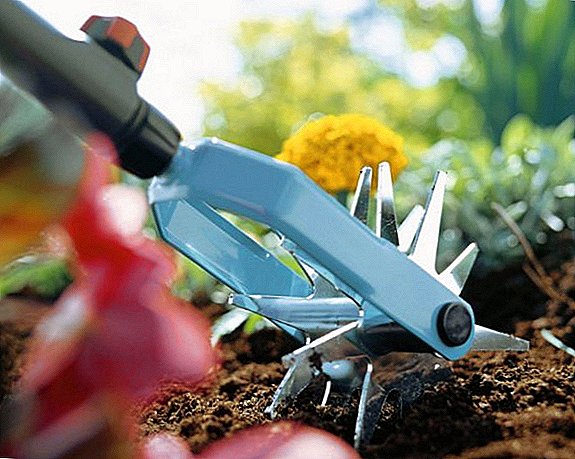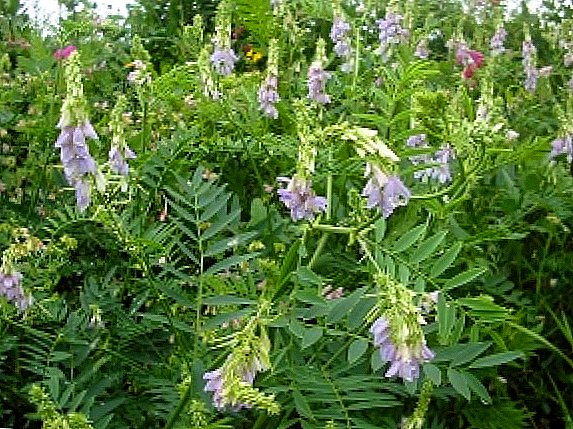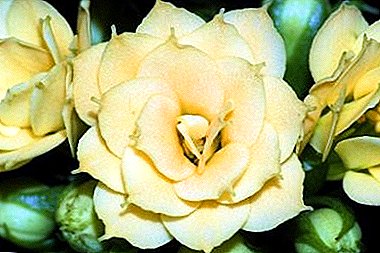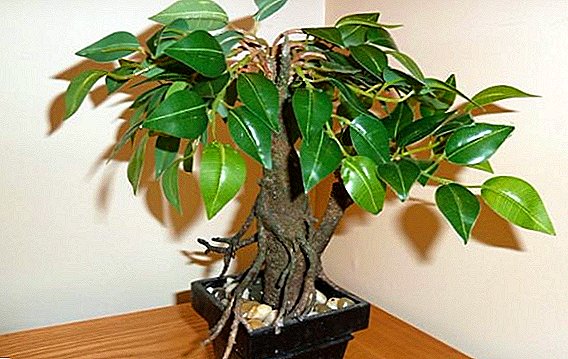 Benjamin Ficus can be found in almost every home where there are indoor plants. Many lovers of home greens are attracted by its beauty and ease of care. But not all growers know whether it is possible to subject this plant to pruning and shaping.
Benjamin Ficus can be found in almost every home where there are indoor plants. Many lovers of home greens are attracted by its beauty and ease of care. But not all growers know whether it is possible to subject this plant to pruning and shaping.
Ficus is a long-lived plant, the height of which, with proper care, does not exceed 2 meters. This is possible only with timely and proper pruning, so it is advisable for a florist to become familiar with several basic rules for conducting this procedure.
When cut ficus: signs and terms
It is very important to determine the correct cutting time for indoor ficus. The peculiarity of these plants living indoors is that their growth is usually slow, but constant. Sometimes the growth of young branches becomes so abundant that the bearing branches of the plant become overloaded and sag down (they can not keep all the green mass on weight).
This process affects the shape of the plant - its branches bend ugly. This is one of the main reasons for pruning. Called young growth pruning "pruning rejuvenation", because it contributes to the correct formation of branches on the plant and in the future will make the form of ficus more compact and attractive. 
Important! Also growing in the house ficus can be cut off when its branches begin to come into contact with furniture, ceiling or other objects in the house. Such pruning will need to be done every time the flower outgrows the space allocated for it.More substantial pruning should be postponed for the winter. Throughout the year you can spend a little pruning in those places where it is necessary to do it. The tree can be cut at a time when it stops the active growth of roots and vegetative mass.
All fig trees, like most other plants, actively grow throughout the spring and summer. By autumn growth slows down, and in winter comes a state of rest. At this time, the plant most calmly reacts to the application of mechanical damage. That is why winter is the best time to subject ficus pruning.
It is advisable for the flower grower to remember that despite the winter pruning recommended by specialists, the removal of dried and sick ficus branches can be done at any time of the year. You do not need to wait until winter. 
Learn how to grow Ficus Benjamin, Bengali, rubber, lyre, Abidjan, Moclame, Kinki, Teineke, Robusta, Melanie, Natasha, Mikrokarpa.
How to trim a ficus
Before you start pruning a plant, you should carefully read the features of its growth.
Any flower branch develops from a bud. Ficus has 2 types of kidneys:
- apical bud - located at the end of the branch (in the upper part);
- axillary kidney - located under the base of the lateral shoot, at the junction of the main stem and the side branch.

Learn how to protect the rubber plant ficus from diseases, why the Benjamin Ficus sheds leaves, how to cure the ficus.Based on the purpose of the pruning, the florist chooses the most favorable time for the procedure:
- Spring pruning - the tree enters the phase of active vegetation, is full of strength and after pruning it, many young shoots start to develop at the same time.
- Autumn pruning - after a stormy summer vegetation, the plant is weakened, therefore, the nipping of the shoots at this time is undesirable, the strength of the ficus is enough to develop only one of the buds, the formation of the plant will turn out to be deformed and curved.
- It is best to prune the ficus in the winter, while the plant is at rest.
Did you know? Japanese florist Kunio Kobayashi, engaged in artistic cultivation of bonsai plants, owns a ficus tree, which is about 800 years old. Master Kobayashi 4 times already won first place in the competition for the most beautiful bonsai, his nursery "Shunk-en", located in Tokyo and open to visitors.
 800 year old bonsai
800 year old bonsaiIn order to correctly form a cicon of a ficus using pruning, you need to remember the sequence of formation:
- The shoot to be trimmed is shortened with a pruner just above the bud.
- The cut on thin branches should be straight, and on old and thick branches the cut is made at an angle of 45 degrees.
- When pruning the side branches, you need to pay attention to the location of the buds. The cut is made over the kidney, which looks towards the room, the internal buds do not leave, as they lead to thickening of the bush.
- Cutting an extra branch, the florist should not leave a stump, as in the future he will reduce the decorativeness of the bush.
- The ficus bush, strongly thickened by internal young growth, needs pruning, as it lacks light and space for growth, which leads to the death of leaves and stems.
- It is extremely important that all the ficus branches growing inside the bush should be mercilessly cut.
- Before starting work, shears (pruner) are checked for sharpness and, if necessary, sharpened. After that, the secateur blades are thoroughly washed with soap and water, wiped dry and wiped with alcohol or alcohol-containing solution for disinfection. The sharpness of the pruner is important for a smooth cut of the branches, and disinfection will not allow the transfer of pathogenic viruses from the instrument to the plant.
- After pruning, the damaged tips of the branches release the juice. Florist with a soft absorbent tissue with light and careful movements removes the juice in sections. At the end of juice extraction, sections on branches are powdered with activated carbon crushed into dust.
Sanitary pruning
Sanitary pruning is used to heal a sick or oppressed plant. Before you start it, you need to eliminate all other possible causes of ficus ailment (first of all, improper care). This type of pruning can affect both the branches and the roots of the plant.
Sanitary pruning of roots:
- Carefully remove your ficus from the pot.
- Place the plant on a well-lit and flat surface, preferably covered with white paper.
- Remove the soil from the roots.
- Look carefully, look for fading roots, or soft, wet, black. Healthy roots of ficus will have a sandy or solid color. Black roots are most likely sick.
- If diseased roots are found, use a sharp, sterile pruner to carefully trim them. Do not remove more than a third of the root system. Make sure that when pruning diseased roots, do not touch healthy roots with a blade that touches infected areas.
Learn how to form a crown of ficus.We carry out sanitary pruning branches:
- When pruning branches and leaves, make sure that the pruner or pruning shears are clean and sterile.
- Examine the tree carefully for any discolored, faded or dead branches and leaves.
- Carefully remove them.
- In some hard-to-reach places it is convenient to work with pruning with the use of long tweezers, which make it easier to pick up the desired branch.
- To re-infect indoor or garden plants, do not add diseased branches of ficus to the compost pile. Take them out of the apartment or at home and put them in a trash can.
 Pruning weak or diseased branches has 2 important functions:
Pruning weak or diseased branches has 2 important functions: - first, it removes any infected or diseased parts of the tree. This gives healthy parts of the plant a chance for recovery;
- secondly, it allows the ficus not to disperse forces on the growth of the useless mass of branches, but to direct the growth energy to the right places. In some cases, pruning can also improve access to sunlight and promote air circulation.
Important! Indoor ficus - a small but very sensitive tree. It loves the sun, and the heat, but hates moving (even to the next window), just turning the pot with a ficus can cause complete or partial loss of leaves.
Anti-aging pruning
Here are some tips on how to rejuvenate a ficus room:
- Make sure the plant is not over-wetted and receives enough heat and light.
- Remove dry leaves or branches.
- Light pruning throughout the year and heavy pruning in the fall or spring.
- As you grow, transplant the tree into a larger pot to increase the area of root nutrition.
- Fertilize it once a month throughout the year.

How to form the crown of ficus
Indoor ficus - a tree, which is directed by forming, you can get different crown shapes and size of the bush. It is important to remember about compliance with sanitary standards when pruning and use only disinfected instruments for this purpose. This plant is bright and beautiful, even without forming, in its natural form, but as a result of the formation very interesting bushes with an unusual shape are obtained.
Correct crown shaping:
- Usually they begin to form a young plant, at this time young shoots are actively growing, they are still plastic, flexible and can be sent to any side convenient for the florist. An adult or old plant will not give as much young growth after shaping or pruning as a young ficus.
- With the help of directional formation, you can eventually get a bonsai tree, a beautiful bush, an interesting figure (arc, pigtail, etc.) or plants with a multi-tiered crown.
- To achieve the desired result, formulating techniques are taken into account, which direct the growth of the tree in the direction of the florist.
- In principle, a home ficus can not be cut off at all, or cut off in case of growing branches with a window or furniture. Bush ficus and without it quite elegant and interesting.
Did you know? The banyan tree (Ficus benghalensis) can resemble a small forest due to fake trunks grown from its roots with air support. The largest banyan tree grows in India and covers an area of over 4 acres.

Learn how to pick up the soil, transplant, water, multiply ficuses.
In the form of a bush
If you want to grow a beautiful ficus in the form of a bush, start forming with pruning all the branches on a young plant after they reach a height of 10 or 15 cm. After this procedure, the axillary buds will actively grow, and young growth will grow rapidly.
After reaching the side branches 8 or 10 cm in length, their tips are also cut off. Since the shoots are constantly pinned points of growth, as a result, the ficus practically does not grow up, but gains volume, gradually turning into a bush or a ball. In order for the bush to be evenly developed, the pot is periodically turned with the other side towards the source of illumination (window, lamp).
Find out what are the ficuses, what are the popular varieties of rubber ficus and Benjamin ficus.

Forming a trunk
To form a young tree in the form of a stem, it is necessary to adhere to the following technology:
- All side branches are removed, only 5 apical buds are left, which will develop into 5 bearing branches of the crown in the future.
- The primary nip point is set based on where the ficus will continue to be. If the plant stands on the floor - the central trunk is cut with shears at a height of 1 meter from the floor, if the pot with a tree lives on a high stand or table - the stem is pinched at a height of 40-50 centimeters from the ground in a pot.
- To support a young plant, a peg or lattice is placed in the pot, to which branches grow as they grow. In the future, the trunk of the ficus will harden and no longer need additional support.
- As the top 5 shoots left grow, they are also pinched.
- This procedure is carried out after the upper shoots have grown to a height of 4-6 buds.
- Pruning is done over the upper bud, looking towards the room (not inside the bush).
- In the future, the density of the bush form exactly the same principle - by pinching the length of the branch. This operation stimulates the development of lateral shoots on the branch, which was cut.
Sometimes the growth rate of a beloved plant is disappointing, find out what are the causes of poor growth of the ficus Benjamin.After the crown is formed in the right amount, florists recommend periodically cutting the overgrown shoots and gently turning the ficus pot to the light source on different sides. But it must be remembered that the ficus is very sensitive to movement in space.
Video: forming a ficus stump
Did you know? Portuguese explorer Pedro Campos discovered Barbados when his ship reached the island in 1536. The researcher saw thickets of sharp figs (Ficus citrifolia) growing abundantly along the coast of the island. Lots of brown roots hung from the branches of growing trees, like unusual strands of hair. Campos called the island of Los Barbados, that is, "bearded."
Tiered Stand
Multi-tiered or sculptural composition can be created from several standard plants. To do this, at the beginning of the cultivation of the flower composition, the height of each plant is regulated. For example, if 5 shoots were left in a pot: 
- on the first shoot, pin the apical (apical) bud at a height of 5 centimeters;
- on the second shoot, the apical buds pinch at a height of 10 cm;
- in the third - at a height of 15-20 cm;
- on the fourth - at a height of 25-30 cm;
- The fifth shoot is left the highest; its height can be 50-60 cm (at the choice of the florist).
Sculpture
In order to create a plant sculpture, several young plants are planted in one pot, and with the directed formation they are given the desired shape during growth. For example, their stems are gradually woven in the form of a basket, fan, or arc.
This can be done manually or with the use of special tools that hold the trunk of young plants in the desired shape, until it becomes woody.
Also used decorative lattices that twist the ficus and, holding, give the desired shape. After the tree has taken a predetermined shape, the grids or retaining pegs are removed.
Video: circular ficus weaving
Bonsai
Creating bonsai plants is an ancient Asian art that takes time, patience, attentiveness and proper pruning. This reception of floriculture reflects the forms and harmony of natural landscapes in detailed, miniature forms.
Ficus are suitable for creating bonsai, especially small-leaved varieties such as Ficus benjamina and Ficus retusa. Ficus grow rapidly, so they require careful and methodical pruning to maintain the size and shape that is traditional for bonsai.
Did you know? Date creepers are amazing parasitic plants that grow on the crowns of other trees from seeds that got there with the help of birds or monkeys. Starting their growth from the crown of trees, seedlings receive a lot of light and energy for growth. Subsequently, dates form aerial roots, which eventually become thick and lignified. They can even strangle and kill the giant trees on which they grow.

Learn how to form a bonsai, what styles of bonsai exist.How to create a bonsai:
- Use small sharp scissors to cut bonsai. Cut only ficus stems, not leaves. Cropped leaves get an untidy look, dry out, a brown border appears on them.
- Make a sketch of the desired shape and note which branches to remove, including any that grow vertically, intersect each other or grow inside. Also plan to remove one branch from two that grows directly opposite to each other, creating a stepped branch.
- Form ficus in the winter before strong spring growth occurs. Start shaping from the bottom of the tree and gradually continue, following the sketched sketch. Use scissors with curved blades to remove branches.
- Treat slices of thick branches with a disinfectant. If this is not done, rotting may start on the branches and the plants will hurt.
- Reduce the growth of branches by pinching them throughout the growing season. At one time, you can trim 2-3 branches. If other branches need pinching, the procedure should be postponed to a later date (2-3 days later).
- If the ficus needs to increase the height or fill the inner space of the crown - you need to allow some shoots to grow in the desired areas.
Did you know? Flowers of fig trees are actually hidden inside the fruit. This was the reason for persistent belief among people that fig trees do not bloom.How to create ficus bonsai: video
Ficus pruning: useful tips
Для грамотного проведения процедуры обрезки стоит придерживаться некоторых несложных советов:
- Обрезка фикуса не сложна, но требует очень тщательного и осторожного подхода. Лучше всего использовать чистую, острую пару секаторов разного размера. Кроме того, не забудьте надеть перчатки, чтобы не повредить руки во время обрезки. It should be borne in mind that Ficus plants have latex juice that irritates the skin. This is another reason to use gloves. You will also need: sharp scissors, a concave cutter-pruner, fixtures (pegs, grids).
- Before pruning, look carefully at the tree to determine the areas that need pruning. If the plant is too tall, you can begin by trimming the apical buds. If the problem is to create a better shape and a clearer silhouette, you will have to think a little about which branch can and should be cut.
 You need to start with the removal of shrunken or damaged branches. This will help determine what kind of plant you want to end up with.
You need to start with the removal of shrunken or damaged branches. This will help determine what kind of plant you want to end up with.- Do not be in a hurry when making a ficus using trimming, so as not to get rid of the necessary elements by chance.
- Fixing (clamping) of thin, long branches in different directions is necessary for the ficus to acquire the required shape.
- Ficus benjamin often develops aerial roots. You can consider the balance of branches with roots for more unusual and attractive trees.
- During the formative pruning, approximately half of the new growth of the branches is removed.
- Florist must follow the rules of pruning. This will help create a beautiful appearance for the ficus and make pruning invisible. The most important rule is to pinch a shoot just before the point of growth. This is necessary to obtain twig growth and hide the stump.
- If the tree is heavily damaged by the disease and has many dry branches, it is best to cut no more than one third of the material. You can always prune later, as soon as the plant gets stronger and starts to grow new shoots. This will help make sure that the live and necessary for further growth is not removed.

Did you know? Sweet dates (fruits of ficus) were important food for several ancient civilizations. Sumerian king Urukagin mentioned in annals of dates almost 5000 years ago, with the king Nebuchadnezzar II they were grown in the hanging gardens of Babylon, the Israeli king Solomon sang them in songs. The ancient Greeks and Romans believed that figs and dates were sent to them by heaven.Home ficus - a very beautiful and plastic plant, its elegant evergreen leaves will enliven the design of any room, even on a gloomy winter day. In addition, the florist can himself choose whether to engage in carrying out pruning and plant formation, or to enjoy the natural type of ficus.
If necessary, you can probably cut off now. But it is better to cut it in the spring, when the plant begins to grow actively. It's not too late for you. How much to cut off depends on what you want to receive. In order for the apical bud not to substitute for the one that turns out to be the top after pruning, and at the top there is no growing upward shoot, it is enough to cut off 5-6 upper buds. But the rubber plant ficus is not always after such pruning side shoots begin to grow, this is how lucky. And it happens that he himself begins to branch with time.
kitti5, I think you need to separately solve the problem of the formation of the crown of your ficus, and separately - the problem of leaf fall. There is no direct dependence here. You have correctly decided to address the narrow topics of discussion of these questions, but it is better not to duplicate posts, but to ask specific questions on this topic. Read more "Leaves are falling": //forum.bestflowers.ru/viewtopic/t/9791/ and "Binding, splicing ficuses": //forum.bestflowers.ru/viewtopic/t/7812/ The tree with one trunk is unlikely to work , a lot will have to be cut, and the roots will have to adapt. It is better to form a bushy bush, or, if possible, twist the trunks.
But to me, he already seems very pretty. For my taste, it is enough to thin out the middle a little and cut the tips to form a compact rounded bush. And it is better to cut in the spring, and now suspend the leaf fall and provide a suitable wintering place.


Between the trunks would put a strut.
Having defined the desired height of a straight trunk, I would cut it off. Between the straight trunk and its side branches, I would also put struts or pull the branches of the straight trunk, attaching weights to them. And these side branches shortened on the principle of "spruce", i.e. the higher the branches, the shorter.
Then I would have thought what to do with a curved trunk. I would hardly have removed it. Maybe it would have made a layer of air.
And as Milo wrote, after pruning a straight trunk and shortening its branches, I would have set the bare part of the trunk to light.
And be sure to replace the top layer of soil to fresh. Somehow, from what is seen in the last photo.



 You need to start with the removal of shrunken or damaged branches. This will help determine what kind of plant you want to end up with.
You need to start with the removal of shrunken or damaged branches. This will help determine what kind of plant you want to end up with.









